Abstract
Modern humanity is facing many challenges, such as declining reserves of fossil energy resources and their increasing prices, climate change and an increase in the number of respiratory diseases including COVID-19. This causes an urgent need to create advanced energy materials and technologies to support the sustainable development of renewable energy systems including hydrogen energy. Layered perovskites have many attractions due to their physical and chemical properties. The structure of such compounds contains perovskite layers divided by layers with different frameworks, which provide their properties’ features. Proton-conduction layered perovskites open up a novel structural class of protonic conductors, potentially suitable for application in such hydrogen energy devices as protonic ceramic electrolysis cells and protonic ceramic fuel cells. In this mini review, the special features of proton transport in the novel class of proton conductors BaLnnInnO3n+1 (n = 1, 2) with a layered perovskite structure are observed and general regularities are discussed.
1. Introduction
Modern humanity is facing many challenges, such as declining reserves of fossil energy resources and their increasing prices [1,2,3,4], climate change [5,6,7,8] and an increase in the number of respiratory diseases including COVID-19 [9,10]. This causes an urgent need to create advanced energy materials and technologies for supporting the sustainable development of renewable energy systems [11,12,13,14,15]. Hydrogen energy, due to eco-friendliness and high efficiency, has a high priority among other renewable energy systems [16,17,18,19,20,21,22]. The joining of forces in the fields of inorganic materials science and engineering for energy production has allowed the creation of such devices for hydrogen production as protonic ceramic electrolysis cells and devices for using hydrogen as a fuel for protonic ceramic fuel cells [23,24,25,26,27,28,29,30,31,32,33,34]. Among other materials, such devices need proton-conducting materials with a high level of proton conductivity and high resistance to carbon dioxide and water vapors [35].
The classic materials investigated as protonic conductors for over forty years such as barium cerates and zirconates have a perovskite structure [36,37,38,39,40]. The realization of protonic conductivity in such types of materials is due to the dissociative intercalation of water molecules into a crystal lattice of complex oxides and subsequent proton transport. Consequently, an increase in proton concentration and mobility should lead to an increase in protonic conductivity in the general case:
where σ is the electrical conductivity; z is the charge of current carriers; c and μ are their corresponding concentration and mobility. The possibility of water uptake for the complex oxides with the perovskite structure ABO3 (Figure 1a) is due to the creation of oxygen vacancies in the structure by the acceptor doping AB1−xMxO3−δ:
where is the oxygen vacancy; is the oxygen atom in the regular position; is the hydroxyl group in the oxygen sublattice. In this case, the oxygen vacancy concentration is strongly dependent on the acceptor dopant concentration and it does not exceed 0.15–0.20 mol water per complex oxide formula unit.
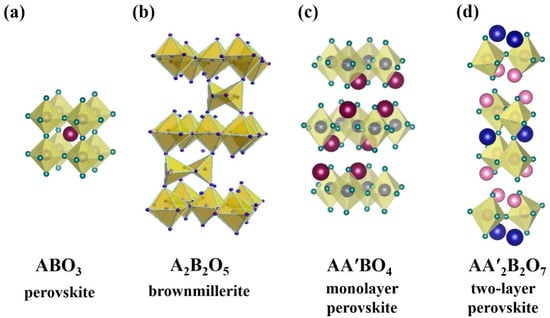
Figure 1.
Crystal structures of perovskite (a), brownmillerite (b), monolayer (c) and two-layer (d) perovskites.
The increase in the oxygen vacancies in the structure can be obtained not only by the modification of the matrix complex oxide structure but also by the principal change in the structural class of material. The acceptor-doped perovskites have an impure oxygen disorder, but the perovskite-related materials with their own structural oxygen disorders such as A4B2B′2O11 (for example Ba4Ca2Nb2O11 [41]) and A2B2O5 (Figure 1b) (for example Ba2In2O5 [42]) are known. The maximal water uptake is achieved for materials with the brownmillerite structure A2B2O5 ≡ ABO2.5 and it is 0.5 mol water per perovskite formula unit:
where is the structural oxygen vacancy; is the oxygen atom in the regular position; is the hydroxyl group in the oxygen sublattice; is the oxygen atom in the interstitial position. Further, overcoming the limitation of the proton concentration in the complex oxide structure needs the next materials search among other perovskite-related structures. In the last decade, layered perovskites have been investigated as prospective materials for use in such electrochemical devices as solid oxide fuel cells (Figure 2), mostly however as electrode materials. In this paper, the details of proton transport in the novel class of proton conductors BaLnnInnO3n+1 (n = 1, 2) with a layered perovskite structure are observed and general regularities are discussed.
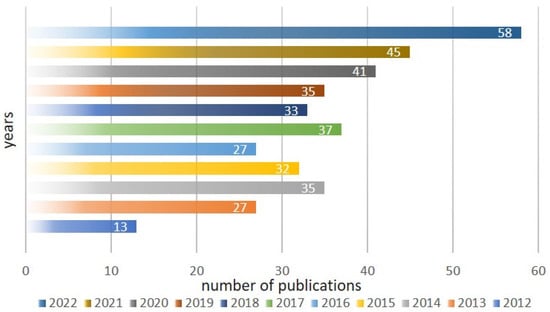
Figure 2.
The progress of recent investigations into layered perovskites as prospective materials for solid oxide fuel cells.
2. Structural Features of Layered Perovskite-Related Materials
In general, layered perovskites can be described as compounds containing perovskite layers divided by layers with different frameworks that provide their property features. Layered perovskites can be classified as Ruddlesden–Popper, Dion–Jacobson and Aurivillius structures. The last two are mostly represented by materials with photocatalytic [43,44,45,46,47,48,49,50,51,52,53], ferroelectric [54,55,56,57,58] and luminescent [59,60,61,62,63] properties. In this paper, we focused on the proton-conducing layered perovskites with a Ruddlesden-Popper structure, which represent a large novel class of proton-conducting materials. They can be described by the general formula An+1BnO3n+1, in which rock salt layers AO and perovskite blocks (ABO3)n are contained. The alternation of rock salt layers and perovskite blocks was described for the first time by S.N. Ruddlesden and P. Popper with the examples of the Sr2TiO4 [64] and Sr2Ti2O7 [65] compounds about sixty-five years ago.
Some of crystal chemical criteria for the existence of layered Ruddlesden-Popper structures such as cation size ratio and bond iconicity IAO, where
are highlighted [66,67,68]. The monolayer (n = 1) AA′BO4 compositions should have in the range 1.473–2.78, and IAO between 0.523 and 0.628. The two-layer (n = 2) AA′2B2O7 compositions are characterized by a cation size ratio 1.606–2.262 and bond iconicity IAO 0.519–0.624. In addition, the compositions must have tetragonal symmetry I4/mmm when the cation size ratio is higher than 1.75 and 1.87 for monolayer and two-layer structures, correspondingly.
Many monolayer AA′BO4 (Figure 1c) compositions including BaLaInO4 have the coordination formula [69]. However, the distortion of the crystal lattice leads to the possibility of other metal coordination numbers. For example, the BaNdInO4 composition is characterized by monoclinic symmetry and it has an coordination formula [70]. The two-layer perovskites (Figure 1d) have an coordination formula, and perovskite blocks consist of titled [BO6] octahedra [68]. This structure is characterized by the ordered arrangement of A- and A′-cations, which can be represented as [AO12] and [A′O9]. In the other words, the A-cations are located between [BO6] octahedra in the perovskite blocks, and the A′-cations are located in the rock salt layers. The ionic radius of the A′-cations is less than the A-cations, i.e., those kinds of atoms enter the inter-block space, whose ionic radius is lower. The decrease in the ionic radius of the rare-earth metal Ln for the layered perovskites leads to the decrease in the space between perovskite blocks, i.e., to the decrease in the Ln–O2 bond and to the increase in [LnO9] polyhedra deformation. This is the reason for the increase in the destabilization of the layered perovskite structure and its approaching a classical perovskite structure.
The presence in the structure of layered perovskites the atoms of which can increase their coordination numbers (, for example) leads to the possibility of water uptake without the existence of oxygen vacancies (Figure 3). This process can be described as:
where is the hydroxyl group in the regular oxygen position; is the hydroxyl group located in the salt rock space. In the other words, the incorporated hydroxyl groups are placed into the salt block space. Consequently, the size of the salt block should play a significant role in the hydration properties of layered perovskites.
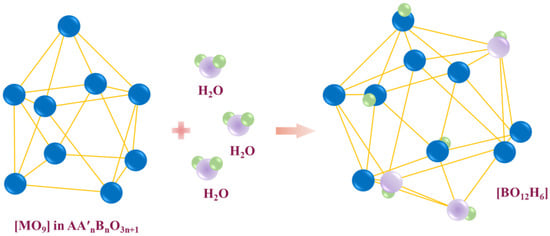
Figure 3.
The schematic representation of the transformation of polyhedra [MO9] to [MO12] upon hydration.
3. Oxygen-Ionic Transport in Layered Perovskite-Related Materials
The oxygen-ionic transport through the crystal lattice of layered perovskites can be described as the migration of oxygen point defects existing in the crystal due to anion Frenkel disorder:
where is the oxygen atom in the regular position; is the oxygen vacancy; is the oxygen atom in the interstitial position. Doping (acceptor and donor) leads to changes in the oxygen stoichiometry, and hypostoichiometry and hyperstoichiometry are the result. Consequently, three possible oxygen migration mechanisms: (i) the direct interstitial mechanism, (ii) the interstitialcy mechanism and (iii) the vacancy mechanism can be considered [71]. The oxygen migration in monolayer perovskites where all elements have stable oxidation states is described by Yang et al. [72] and by Fujii et al. [73] for acceptor-doped compositions based on BaNdInO4. Both are proposed 2D oxygen ion diffusion mechanisms within rock salt layers. The mechanism of oxygen-ionic transport for the two-layer perovskite BaLn2In2O7 approved by calculation methods such as molecular dynamic simulation is not provided yet. However, we can suppose that ionic conductivity values must depend on the crystal structure features of layered compositions. The ratios of salt layers and perovskite blocks are 1:1 and 1:2 for monolayer and two-layer perovskites, correspondingly. Consequently, the ionic conductivity for two-layer perovskites must be lower in comparison with the conductivity for monolayer perovskites in the case of the realization of the 2D oxygen ion diffusion mechanisms for both. Oppositely, conductivity for the BaLn2In2O7 composition will be higher than for BaLnInO4 if the 3D transport mechanism is realized for the first.
Figure 4 represents the temperature dependencies of the electrical conductivity values obtained under dry air for the monolayers BaLaInO4 [74] and BaNdInO4 [70,71] and the two-layer BaLa2In2O7 [74] and BaNd2In2O7 [75] compositions. All of these samples were obtained by the solid-state method. The qualitative and quantitative compositions of the samples were confirmed by various methods such as XRD, SEM, EDS, EDX, etc. As can be seen, conductivity increases in the rows BaLaInO4-BaNdInO4 and BaLa2In2O7-BaNd2In2O7; i.e., Nd-containing compositions are more conductive than La-containing ones despite the number of n in the layered BaLnnInnO3n+1 structure. At the same time, two-layer compositions are more conductive than monolayer compounds. That is, the assumption about the 3D oxygen ion diffusion mechanism for two-layer perovskites BaLn2In2O7 is confirmed.
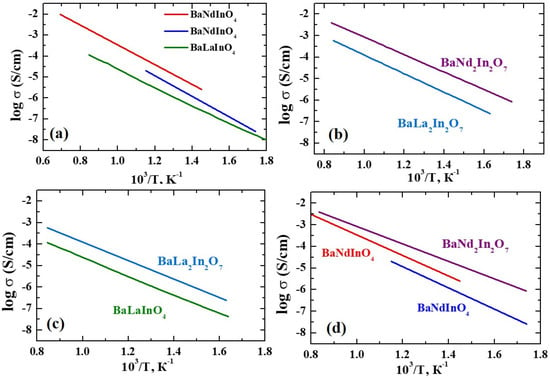
Figure 4.
The temperature dependencies of electrical conductivity values obtained under dry air for monolayer BaLaInO4 [74], BaNdInO4 [70,71] compositions (a), two-layer BaLa2In2O7 [74] and BaNd2In2O7 [75] compositions (b), La-containing BaLaInO4 [74] and BaLa2In2O7 [74] compositions (c), Nd-containing BaNdInO4 [70,71] and BaNd2In2O7 [75] compositions (d).
The acceptor doping of the layered perovskites BaLnnInnO3n+1 can be described as:
where is the acceptor dopant in the sublattice of the rare-earth metal Ln; is the oxygen atom in the regular position; is the oxygen vacancy. The appearance of oxygen vacancies in the crystal lattice of layered perovskites leads to the increase in conductivity values for both the monolayer BaLnInO4 and two-layer BaLa2In2O7 compositions. However, some features can be highlighted. Firstly, the increase in the conductivity values for the monolayer BaLaInO4 [76,77,78,79,80,81,82,83] and BaNdInO4 [70,72,73,84,85,86] compositions is more significant than for the two-layer BaLa2In2O7 [74,87,88,89,90] and BaNd2In2O7 [75,91] compositions (~1.5 vs. ~1. order of magnitude). Secondly, both the monolayer BaLnInO4 and two-layer BaLn2In2O7 compositions have different conductivity values with the same acceptor dopant concentration. Thirdly, the conductivity changes non-linearly with the increase in oxygen vacancy concentration.
The donor doping of the layered perovskite BaLnnInnO3n+1 can be described as:
where is the donor dopant in the indium sublattice; is the oxygen atom in the interstitial position. As opposed to acceptor doping, donor doping can be realized only for the monolayer BaLnInO4 composition. The only mention of donor-doped two-layered composition was for BaLa2In0.9Ti0.1O7.05; however, the conductivity values for it were lower than for the undoped BaLa2In2O7 composition [78]. Consequently, it can be summarized that the crystal lattice of the two-layer BaLn2In2O7 perovskites is less tolerant to the presence of “additional” interstitial oxygen in comparison with the monolayer BaLnInO4 perovskites. The possibility of isovalent doping was proved for the monolayer and two-layer La-containing composition. The compositions with the doping of the La-sublattice BaLa0.9Gd0.1InO4 [81], BaLa0.9Nd0.1InO4 [82], BaLa2–xGdxIn2O7 0 ≤ x ≤ 0.15 [90] and In-sublattice BaLaIn0.9Sc0.1O4 [79], BaLaIn1−xYxO4 (0 ≤ x ≤ 0.5) [80] were obtained and investigated.
The correlation between changes in the structural characteristics (lattice parameters, unit cell volumes) and conductivity values for doped compositions based on BaLaInO4 and BaLa2In2O7 is presented in Figure 5. The increase in the unit cell volume for monolayer compositions is due to the increase in the a lattice parameter, which indicates the increase in the distance between perovskite blocks. In general, this increase correlates well with the increase in electrical conductivity values upon doping. It allows us to say that the geometric factor has a significant effect on the change in electrical conductivity. This is also a key factor in understanding why related compositions have different conductivity at the same concentration of oxygen vacancies. It should be noted that the reasons for the increase in lattice parameters are different for each type of doping. The introduction of acceptor dopants with bigger ionic radii (Sr/Ba → La), the appearance of “additional” interstitial oxygen during donor doping and the appearance of the additional repulsion effects of the different nature ions in one sublattice during isovalent doping can be named as the more significant reasons for the increase in the a lattice parameter.
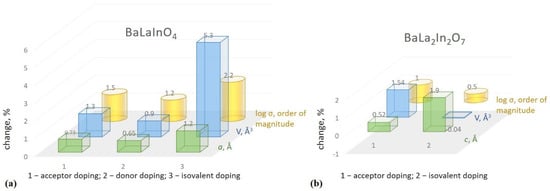
Figure 5.
The changes in the lattice parameters, unit cell volumes and oxygen-ionic conductivity values for doped compositions based on monolayer BaLaInO4 (a) and two-layer BaLa2In2O7 perovskites (b).
For two-layer perovskites based on BaLa2In2O7, the clearer correlation is between the c lattice parameter, which indicates the increase in the distance between perovskite blocks for this type of crystal structure, and conductivity values. As it was for monolayer compositions, the increase in the distance between perovskite blocks leads to the increase in the conductivity values. However, this increase is smaller, which can be explained by different conduction mechanisms for each type of layered structure.
Despite the increase in distance between perovskite blocks during heterovalent (donor and acceptor) doping, conductivity values increase at the “small” dopant concentrations (i.e., at “small” oxygen point defect ( or ) concentrations) and decrease at the “big” concentrations. The most probable reason is the formation of clusters with lower mobility and a decrease in the concentration of mobile oxygen defects. The defect association can describe the acceptor type of doping as:
or
and for the donor type of doping as
or
It is clear that both factors, the increase in the lattice parameters (geometric factor) and the increase in the oxygen defects concentration (concentration factor), affect the electrical conductivity value simultaneously. Consequently, the exclusion of one of these factors can help determine the most significant cause of changes in the electrical conductivity values. Both heterovalent doping and isovalent doping lead to an increase in the lattice parameters, but the oxygen concentration does not change.
Figure 6 represents the concentration dependencies of the oxygen-ionic conductivities for heterovalent-doped BaLa1–xBaxInO4–0.5x [76], BaLaIn1–xTixO4+0.5x [78], BaLa2–xBaxIn2O7–x [89] and isovalent-doped BaLaIn1−xYxO4 [80], BaLa2–xGdxIn2O7 [91] compositions. As can be seen, isovalent doping allows the obtaining of more conductive compositions at the same dopant concentration for monolayer perovskites based on BaLaBaInO4. Conversely, acceptor doping is a more suitable way to increase the conductivity values of two-layered perovskites compared with isovalent doping. The crystal lattice of monolayer BaLnInO4 perovskites is more flexible than two-layer BaLa2In2O7 perovskites, which allows for a more significant increase in the distance between perovskite blocks and in the conductivity values. However, the decrease in the conductivity values at a “big” acceptor dopant concentration is more valuable for monolayer BaLa1–xBaxInO4–0.5x perovskites compared with two-layer BaLa2–xBaxIn2O7–x. We can suppose that the reason for this difference is the change in the ratio of perovskite blocks and salt layers and in the mechanism of oxygen transport.
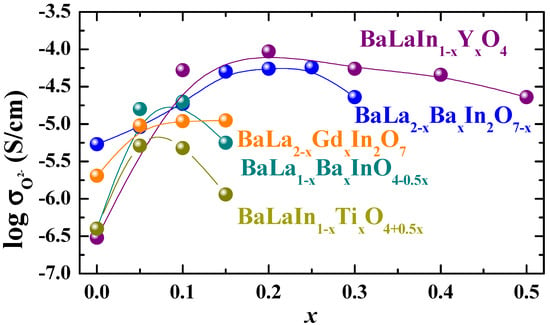
Figure 6.
The concentration dependencies of oxygen-ionic conductivities for heterovalent-doped BaLa1–xBaxInO4–0.5x [76], BaLaIn1–xTixO4+0.5x [78], BaLa2–xBaxIn2O7–x [89] and isovalent-doped BaLaIn1−xYxO4 [80], BaLa2–xGdxIn2O7 [91] compositions at 500 °C.
4. Proton Transport in Layered Perovskite-Related Materials
Protonic conductivity directly depends on the proton concentration in the structure (Equation (1)), and the possibility of water uptake for layered perovskites is very important. The possibility for water intercalation for undoped and doped layered BaLaInO4 perovskites was proved, and the absence of correlation between oxygen vacancy concentration and water uptake was shown [77]. Figure 7a represents the dependency of water uptake vs. unit cell volume for monolayer perovskites. As we can see, the water uptake for doped perovskites based on BaLaInO4 is much higher than for classical ABO3 perovskites (up to ~2 mol water per complex oxide formula unit). In addition, the water uptake for isovalent-doped compositions is higher in comparison with isovalent-doped compositions. The possible reason is the absence of “additional” oxygen point defects ( or ) in the salt layer space, which can make the dissociative intercalation of water molecules into the crystal lattice difficult.
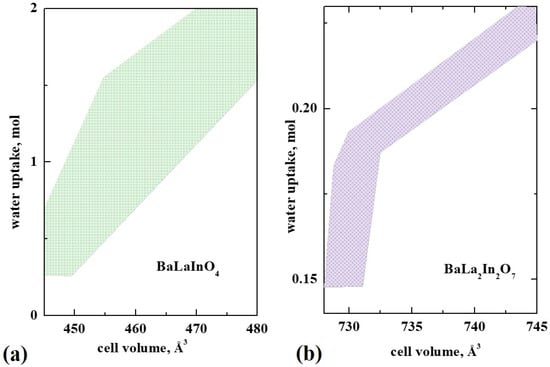
Figure 7.
The dependencies of water uptake for doped compositions based on BaLaInO4 monolayer (a) and two-layer BaLa2In2O7 (b) perovskites.
The dependency of water uptake vs. unit cell volume for two-layer perovskites is presented in the Figure 7b. Contrary to monolayer perovskites, the changes in the unit cell volume do not significantly affect the amount of water uptake. It slightly increases with the increase in oxygen concentration, but it does not reach the maximum possible values equal to the concentration of vacancies. In general, the water uptake for all undoped and doped two-layer perovskites based on BaLn2In2O7 is about 0.10–0.22 mol per complex oxide formula unit [87], which is comparable with the values for acceptor-doped classic perovskites.
The concentration dependencies of the proton conductivity values for monolayer and two-layer compositions are presented in Figure 8. As can be seen, the general regularities of protonic conductivity are similar to the regularities of oxygen-ionic conductivity (Figure 6). The decrease in the proton conductivity at a “big” dopant concentration is observed for heterovalent-doped monolayer perovskites based on BaLaInO4. The cluster formation can be named as the reason for this decrease and it can be expressed by the following equations:
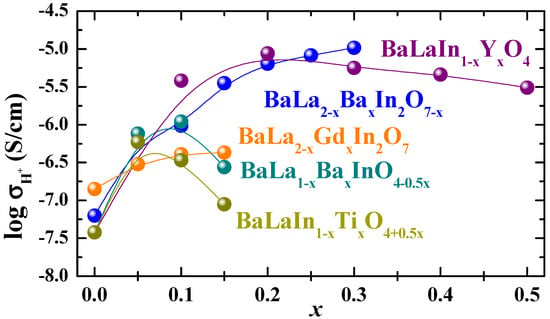
Figure 8.
The concentration dependencies of protonic conductivities for heterovalent-doped BaLa1–xBaxInO4–0.5x [76], BaLaIn1–xTixO4+0.5x [78], BaLa2–xBaxIn2O7–x [86] and isovalent-doped BaLaIn1−xYxO4 [80], BaLa2–xGdxIn2O7 [90] compositions at 300 °C.
The greatest increase in conductivity is achieved by isovalent doping for monolayer compositions and by acceptor doping for two-layer compositions. The comparison of the protonic conductivity values of layered perovskites BaLnnInnO3n+1 (n = 1, 2) is presented in Table 1. The conductivity values for most conductive monolayer BaLaIn1−xYxO4 and two-layer BaLa2–xBaxIn2O7–x compositions are comparable. This allows us to say that a significant decrease (about one order of magnitude) in the proton concentration for two-layer perovskites compared to monolayer perovskites is compensated for by the increase in their mobility. Obviously, this increase is due to the increase in oxygen-ion mobility since the transfer of protons is carried out by moving along oxygen ions. We can suggest that the inclusion of perovskite blocks in the crystal lattice (two-layer perovskites) and the creation of oxygen vacancies into them (acceptor doping) change the transport mechanism from 2D to 3D and significantly increase the ionic conductivity values. In general, an increase in the number of perovskite stacks in the blocks of the layered structure leads to an increase in the ionic conductivity values of the layered perovskites BaLnnInnO3n+1 (n = 1, 2).

Table 1.
The comparison of the protonic conductivity values of layered perovskites BaLnnInnO3n+1 (n = 1, 2).
One of the next steps for using layered perovskites for electrochemical applications is the transition from material creation to manufacturing technology. In this regard, the problem of comparability between materials of different device components such as electrode and electrolyte materials becomes very important. We believe that the investigation of stacks where both electrode and electrolyte materials have a layered structure will happen in the near future.
5. Conclusions
In this paper, the specifics of proton transport in the novel class of proton conductors BaLnnInnO3n+1 (n = 1, 2) with a layered perovskite structure are observed and general regularities are discussed. The conductivity values are strongly dependent on the nature of the rare-earth metal Ln and of a number of perovskite n stacks in the structure. The Nd-containing compositions are more conductive than the La-containing ones at the same n. When the nature of the rare-earth metal does not change, two-layer perovskites have higher conductivity values in comparison with monolayer compounds. The crystal lattice of monolayer perovskites is more “flexible” and allows the performance of various types of doping such as acceptor, donor and isovalent doping, while donor doping is not suitable for the two-layer perovskite structure. The water uptake for doped monolayer perovskites is much higher than for classical ABO3 perovskites (up to ~2 mol water per complex oxide formula unit) and it is comparable (~0.2 mol water) for two-layer perovskites. The greatest increase in conductivity is achieved by isovalent doping for monolayer compositions and by acceptor doping for two-layer compositions. At the same time, the conductivity values for most conductive monolayer BaLaIn1−xYxO4 and two-layer BaLa2–xBaxIn2O7–x compositions are comparable.
We can conclude that the increase in the number of perovskite stacks in the blocks of the layered structure approaches the properties of the layered perovskite closer to classical perovskite. The ionic conductivity values of layered perovskites BaLnnInnO3n+1 (n = 1, 2) increase with increasing n, but the water uptake decreases. At the same time, layered perovskites are a prospective class due to their structural “flexibility”, ability to vary the concentration of protons and conductivity over a wide range (up to 2 orders of magnitude) during doping. The optimal combination of cations and doping method will allow the obtaining of novel high-conductive materials suitable for application as protonic electrolytes in different electrochemical devices, and the next materials search will be very relevant.
Funding
This research was supported by the Russian Science Foundation (grant no 22-79-10003).
Institutional Review Board Statement
Not applicable.
Data Availability Statement
Not applicable.
Conflicts of Interest
The authors declare no conflict of interest.
References
- Malerba, D. Poverty-energy-emissions pathways: Recent trends and future sustainable development goals. Int. J. Sustain. Energy Dev. 2019, 49, 109–124. [Google Scholar] [CrossRef]
- Buonomano, A.; Barone, G.; Forzano, C. Advanced energy technologies, methods, and policies to support the sustainable development of energy, water and environment systems. Energy Rep. 2022, 8, 4844–4853. [Google Scholar] [CrossRef]
- Chu, S.; Majumdar, A. Opportunities and challenges for a sustainable energy future. Nature 2012, 48, 294–303. [Google Scholar] [CrossRef] [PubMed]
- Østergaard, P.A.; Duic, N.; Noorollahi, Y.; Mikulcic, H.; Kalogirou, S. Sustainable development using renewable energy technology. Renew. Energy 2020, 146, 2430–2437. [Google Scholar] [CrossRef]
- Olabi, A.G.; Abdelkareem, M.A. Renewable energy and climate change. Renew. Sustain. Energy Rev. 2022, 158, 112111. [Google Scholar] [CrossRef]
- Corvalan, C.; Prats, E.V.; Sena, A.; Varangu, L.; Vinci, S. Towards climate resilient and environmentally sustainable health care facilities. Int. J. Environ. Res. Public Health 2020, 17, 8849. [Google Scholar] [CrossRef]
- Watts, N.; Amann, M.; Arnell, N.; Montgomery, H.; Costello, A. The 2020 report of the Lancet countdown on health and climate change: Responding to converging crises. Lancet 2021, 397, 129–170. [Google Scholar] [CrossRef]
- Kats, G.H. Slowing global warming and sustaining development: The promise of energy efficiency. Energy Policy 1990, 18, 25–33. [Google Scholar] [CrossRef]
- Afroze, S.; Reza, M.S.; Cheok, Q.; Taweekun, J.; Azad, A.K. Solid oxide fuel cell (SOFC); A new approach of energy generation during the pandemic COVID-19. Int. J. Integr. Eng. 2020, 12, 245–256. [Google Scholar] [CrossRef]
- Afroze, S.; Reza, M.S.; Cheok, Q.; Islam, S.N.; Abdalla, A.M.; Taweekun, J.; Azad, A.K.; Khalilpoor, N.; Issakhov, A. Advanced applications of fuel cells during the COVID-19 Pandemic. Int. J. Chem. Eng. 2021, 2021, 5539048. [Google Scholar] [CrossRef]
- Dincer, I. Renewable energy and sustainable development: A crucial review. Renew. Sustain. Energy Rev. 2000, 4, 157–175. [Google Scholar] [CrossRef]
- Stambouli, A.B.; Traversa, E. Solid oxide fuel cells (SOFCs): A review of an environmentally clean and efficient source of energy. Renew. Sustain. Energy Rev. 2002, 6, 433–455. [Google Scholar] [CrossRef]
- Panwar, N.L.; Kaushik, S.C.; Kothari, S. Role of renewable energy sources in environmental protection: A review. Renew. Sustain. Energy Rev. 2011, 15, 1513–1524. [Google Scholar] [CrossRef]
- Dincer, I.; Rosen, M.A. Sustainability aspects of hydrogen and fuel cell systems. Int. J. Sustain. Energy Dev. 2011, 15, 137–146. [Google Scholar] [CrossRef]
- Branco, H.; Castro, R.; Lopes, A.S. Battery energy storage systems as a way to integrate renewable energy in small isolated power systems. Int. J. Sustain. Energy Dev. 2018, 43, 90–99. [Google Scholar] [CrossRef]
- International Energy Agency. The Future of Hydrogen: Seizing today’s opportunities. OECD 2019. [Google Scholar] [CrossRef]
- Abe, J.O.; Popoola, A.P.I.; Ajenifuja, E.; Popoola, O.M. Hydrogen energy, economy and storage: Review and recommendation. Int. J. Hydrog. Energy 2019, 44, 15072–15086. [Google Scholar] [CrossRef]
- Dawood, F.; Anda, M.; Shafiullah, G.M. Hydrogen production for energy: An overview. Int. J. Hydrog. Energy 2019, 45, 3847–3869. [Google Scholar] [CrossRef]
- Easily, R.R.; Chi, Y.; Ibrahiem, D.M.; Chen, Y. Hydrogen strategy in decarbonization era: Egypt as a case study. Int. J. Hydrog. Energy 2022, 47, 18629–18647. [Google Scholar] [CrossRef]
- Arsad, A.Z.; Hannan, M.A.; Al-Shetwi, A.Q.; Mansur, M.; Muttaqi, K.M.; Dong, Z.Y.; Blaabjerg, F. Hydrogen energy storage integrated hybrid renewable energy systems: A review analysis for future research directions. Int. J. Hydrog. Energy 2022, 47, 17285–17312. [Google Scholar] [CrossRef]
- Scovell, M.D. Explaining hydrogen energy technology acceptance: A critical review. Int. J. Hydrog. Energy 2022, 47, 10441–104591. [Google Scholar] [CrossRef]
- Abdalla, A.M.; Hossain, S.; Nisfindy, O.B.; Azad, A.T.; Dawood, M.; Azad, A.K. Hydrogen production, storage, transportation and key challenges with applications: A review. Energy Convers. Manag. 2018, 165, 602–627. [Google Scholar] [CrossRef]
- Hossain, S.; Abdalla, A.M.; Jamain, S.N.B.; Zaini, J.H.; Azad, A.K. A review on proton conducting electrolytes for clean energy and intermediate temperature-solid oxide fuel cells. Renew. Sustain. Energy Rev. 2017, 79, 750–764. [Google Scholar] [CrossRef]
- Kim, J.; Sengodan, S.; Kim, S.; Kwon, O.; Bu, Y.; Kim, G. Proton conducting oxides: A review of materials and applications for renewable energy conversion and storage. Renew. Sustain. Energy Rev. 2019, 109, 606–618. [Google Scholar] [CrossRef]
- Zhang, W.; Hu, Y.H. Progress in proton-conducting oxides as electrolytes for low-temperature solid oxide fuel cells: From materials to devices. Energy Sci. Eng. 2021, 9, 984–1011. [Google Scholar] [CrossRef]
- Meng, Y.; Gao, J.; Zhao, Z.; Amoroso, J.; Tong, J.; Brinkman, K.S. Review: Recent progress in low-temperature proton-conducting ceramics. J. Mater. Sci. 2019, 54, 9291–9312. [Google Scholar] [CrossRef]
- Medvedev, D. Trends in research and development of protonic ceramic electrolysis cells. Int. J. Hydrog. Energy 2019, 44, 26711–26740. [Google Scholar] [CrossRef]
- Medvedev, D.A. Current drawbacks of proton-conducting ceramic materials: How to overcome them for real electrochemical purposes. Curr. Opin. Green Sustain. Chem. 2021, 32, 100549. [Google Scholar] [CrossRef]
- Zvonareva, I.; Fu, X.-Z.; Medvedev, D.; Shao, Z. Electrochemistry and energy conversion features of protonic ceramic cells with mixed ionic-electronic electrolytes. Energy Environ. Sci. 2022, 15, 439–465. [Google Scholar] [CrossRef]
- Shim, J.H. Ceramics breakthrough. Nature Energy 2018, 3, 168–169. [Google Scholar] [CrossRef]
- Bello, I.T.; Zhai, S.; He, Q.; Cheng, C.; Dai, Y.; Chen, B.; Zhang, Y.; Ni, M. Materials development and prospective for protonic ceramic fuel cells. Int. J. Energy Res. 2021, 46, 2212–2240. [Google Scholar] [CrossRef]
- Chiara, A.; Giannici, F.; Pipitone, C.; Longo, A.; Aliotta, C.; Gambino, M.; Martorana, A. Solid-Solid Interfaces in Protonic Ceramic Devices: A Critical Review. ACS Appl. Mater. Interfaces 2020, 12, 55537–55553. [Google Scholar] [CrossRef] [PubMed]
- Cao, J.; Ji, Y.; Shao, Z. New Insights into the Proton-Conducting Solid Oxide Fuel Cells. J. Chin. Ceram. Soc. 2021, 49, 83–92. [Google Scholar] [CrossRef]
- Bello, I.T.; Zhai, S.; Zhao, S.; Li, Z.; Yu, N.; Ni, M. Scientometric review of proton-conducting solid oxide fuel cells. Int. J. Hydrog. Energy 2021, 46, 37406–37428. [Google Scholar] [CrossRef]
- Colomban, P. Proton conductors and their applications: A tentative historical overview of the early researches. Solid State Ionics 2019, 334, 125–144. [Google Scholar] [CrossRef]
- Iwahara, H.; Esaka, T.; Uchida, H.; Maeda, N. Proton conduction in sintered oxides and its application to steam electrolysis for hydrogen production. Solid State Ion. 1981, 3–4, 359–363. [Google Scholar] [CrossRef]
- Iwahara, H.; Uchida, H.; Maeda, N. High temperature fuel and steam electrolysis cells using proton conductive solid electrolytes. J. Power Sources 1982, 7, 293–301. [Google Scholar] [CrossRef]
- Iwahara, H.; Uchida, H.; Tanaka, S. High temperature type proton conductors based on SrCeO3 and its application to solid electrolyte fuel cells. Solid State Ion. 1983, 9–10, 1021–1025. [Google Scholar] [CrossRef]
- Irvine, J.; Rupp, J.L.M.; Liu, G.; Xu, X.; Haile, S.; Qian, X.; Snyder, A.; Freer, R.; Ekren, D.; Skinner, S.; et al. Roadmap on inorganic perovskites for energy applications. J. Phys. Energy 2021, 3, 031502. [Google Scholar] [CrossRef]
- Hossain, M.K.; Chanda, R.; El-Denglawey, A.; Emrose, T.; Rahman, M.T.; Biswas, M.C.; Hashizume, K. Recent progress in barium zirconate proton conductors for electrochemical hydrogen device applications: A review. Ceram. Int. 2021, 47, 23725–23748. [Google Scholar] [CrossRef]
- Tarasova, N.; Colomban, P.; Animitsa, I. The short-range structure and hydration process of fluorine-substituted double perovskites based on barium-calcium niobate Ba2CaNbO5.5. J. Phys. Chem. Solids 2018, 118, 32–39. [Google Scholar] [CrossRef]
- Cichy, K.; Skubida, W.; Świerczek, K. Structural transformations, water incorporation and transport properties of tin-substituted barium indate. J. Solid State Chem. 2018, 262, 58–67. [Google Scholar] [CrossRef]
- Domen, K.; Yoshimura, J.; Sekine, T.; Tanaka, A.; Onishi, T. A novel series of photocatalysts with an ion-exchangeable layered structure of niobate. Catal Lett. 1990, 4, 339–343. [Google Scholar] [CrossRef]
- Machida, M.; Yabunaka, J.; Kijima, T. Efficient photocatalytic decomposition of water with the novel layered tantalate RbNdTa2O7. Chem. Commun. 1999, 19, 1939–1940. [Google Scholar] [CrossRef]
- Machida, M.; Miyazaki, K.; Matsushima, S.; Arai, M. Photocatalytic properties of layered perovskite tantalates, MLnTa2O7 (M = Cs, Rb, Na, and H; Ln = La, Pr, Nd, and Sm). J. Mater. Chem. 2003, 13, 1433–1437. [Google Scholar] [CrossRef]
- Rodionov, I.A.; Zvereva, I.A. Photocatalytic activity of layered perovskite-like oxides in practically valuable chemical reactions. Russ. Chem. Rev. 2016, 85, 248–279. [Google Scholar] [CrossRef]
- Krasheninnikova, O.V.; Syrov, E.V.; Smirnov, S.M.; Suleimanov, E.V.; Fukina, D.G.; Knyazev, A.V.; Titaev, D.N. Synthesis, crystal structure and photocatalytic activity of new Dion-Jacobson type titanoniobates. J. Solid State Chem. 2022, 315, 123445. [Google Scholar] [CrossRef]
- Phuruangrat, A.; Ekthammathat, N.; Dumrongrojthanath, P.; Thingtem, S.; Thongtem, T. Hydrothermal synthesis, structure, and optical properties of pure and silver-doped Bi2MoO6 nanoplates. Russ. J. Phys. Chem. 2015, 89, 2443–2448. [Google Scholar] [CrossRef]
- Chawla, H.; Chandra, A.; Ingole, P.P.; Garg, S. Recent advancements in enhancement of photocatalytic activity using bismuth-based metal oxides Bi2MO6 (M = W, Mo, Cr) for environmental remediation and clean energy production. Ind. Eng. Chem. Res. 2021, 95, 1–15. [Google Scholar] [CrossRef]
- Tasleem, S.; Tahir, M. Recent progress in structural development and band engineering of perovskites materials for photocatalytic solar hydrogen production: A review. Int. J. Hydrog. Energy 2020, 45, 19078–19111. [Google Scholar] [CrossRef]
- Huang, Y.; Liu, J.; Deng, Y.; Qian, Y.; Jia, X.; Ma, M.; Yang, C.; Liu, K.; Wang, Z.; Qu, S.; et al. The application of perovskite materials in solar water splitting. J. Semicond. 2020, 41, 011701. [Google Scholar] [CrossRef]
- Zhang, G.; Liu, G.; Wang, L.; Irvine, J.T.S. Inorganic perovskite photocatalysts for solar energy utilization. Chem. Soc. Rev. 2016, 45, 5951–5984. [Google Scholar] [CrossRef] [PubMed]
- Zhang, P.; Zhang, J.; Gong, J. Tantalum-based semiconductors for solar water splitting. Chem. Soc. Rev. 2014, 43, 4395–4422. [Google Scholar] [CrossRef] [PubMed]
- Benedek, N.A.; Rondinelli, J.M.; Djani, H.; Ghosez, P.; Lightfoot, P. Understanding ferroelectricity in layered perovskites: New ideas and insights from theory and experiments. Dalton Trans. 2015, 44, 10543–10558. [Google Scholar] [CrossRef]
- Ferreira, W.C.; Rodrigues, G.L.C.; Araújo, B.S.; de Aguiar, F.A.A.; de Abreu Silva, A.N.A.; Fechine, P.B.A.; de Araujo Paschoal, C.W.; Ayala, A.P. Pressure-induced structural phase transitions in the multiferroic four-layer Aurivillius ceramic Bi5FeTi3O15. Ceramics 2020, 46, 18056–180621. [Google Scholar] [CrossRef]
- Zulhadjri; Wendari, T.P.; Ikhram, M.; Putri, Y.E.; Septiani, U.; Imelda. Enhanced dielectric and ferroelectric responses in La3+/Ti4+ co-substituted SrBi2Ta2O9 Aurivillius phase. Ceram. Int. 2022, 48, 10328–103321. [Google Scholar] [CrossRef]
- Xu, Q.; Xie, S.; Wang, F.; Liu, J.; Shi, J.; Xing, J.; Chen, Q.; Zhu, J.; Wang, Q. Bismuth titanate based piezoceramics: Structural evolutions and electrical behaviors at different sintering temperatures. J. Alloys Compd. 2021, 882, 160637. [Google Scholar] [CrossRef]
- Chen, C.; Ning, H.; Lepadatu, S.; Cain, M.; Yan, H.; Reece, M.J. Ferroelectricity in Dion-Jacobson ABiNb2O7 (A = Rb, Cs) compounds. J. Mater. Chem. C 2015, 3, 19–22. [Google Scholar] [CrossRef]
- Kudo, A.; Kaneko, E. Photoluminescence of layered perovskite oxides with triple-octahedra slabs containing titanium and niobium. J. Mater. Sci. Lett. 1997, 16, 224–226. [Google Scholar] [CrossRef]
- Pavani, K.; Graça, M.P.F.; Kumar, J.S.; Neves, A.J. Photoluminescence varied by selective excitation in BiGdWO6:Eu3+ phosphor. Opt. Mater. 2017, 74, 120–127. [Google Scholar] [CrossRef]
- Mamidi, S.; Gundeboina, R.; Kurra, S.; Velchuri, R.; Muga, V. Aurivillius family of layered perovskites, BiREWO6 (RE = La, Pr, Gd, and Dy): Synthesis, characterization, and photocatalytic studies. C. R. Chim. 2018, 21, 547–552. [Google Scholar] [CrossRef]
- Zhou, G.; Jiang, X.; Zhao, J.; Molokeev, M.; Lin, Z.; Liu, Q.; Xia, Z. Two-dimensional-layered perovskite ALaTa2O7:Bi3+ (A = K and Na) phosphors with versatile structures and tunable photoluminescence. ACS Appl. Mater. Interfaces 2018, 10, 24648–24655. [Google Scholar] [CrossRef] [PubMed]
- Panda, D.P.; Singh, A.K.; Kundu, T.K.; Sundaresan, A. Visible-light excited polar Dion-Jacobson Rb(Bi1-xEux)2Ti2NbO10 perovskites: Photoluminescence properties and in vitro bioimaging. J. Mater. Chem. B 2022, 10, 935–944. [Google Scholar] [CrossRef]
- Ruddlesden, S.N.; Popper, P. New compounds of the K2NiF4 type. Acta Cryst. 1957, 10, 538–539. [Google Scholar] [CrossRef]
- Ruddlesden, S.N.; Popper, P. The compound Sr3Ti2O7 and its structure. Acta Cryst. 1958, 11, 54–55. [Google Scholar] [CrossRef]
- Ganguly, P.; Rao, C.N.R. Crystal Chemistry and Magnetic Properties of Layered Metal Oxides Possessing the K2NiF4 or Related Structures. J. Solid State Chem. 1984, 53, 193–216. [Google Scholar] [CrossRef]
- Ganculi, D. Cationic radius ratio and formation of K2NiF4-type compounds. J. Solid State Chem. 1979, 30, 353–356. [Google Scholar] [CrossRef]
- Tyitov, Y.O.; Slobodyanik, M.S.; Polubinskii, V.V. Criteria of existence of one- and two-layer compounds (MeIILn)n+1BnO3n+1. Dopov. Natsyional’noyi Akad. Nauk. Ukrayini 2018, 2018, 80–85. [Google Scholar] [CrossRef]
- Tyitov, Y.O.; Byilyavina, N.M.; Markyiv, V.Y.; Slobodyanik, M.S.; Krajevs’ka, Y.A. Synthesis and crystal structure of BaLaInO4 and SrLnInO4 (Ln−La, Pr). Dopov. Natsyional’noyi Akad. Nauk. Ukrayini 2009, 10, 160–166. [Google Scholar]
- Fijii, K.; Yashima, M. Discovery and development of BaNdInO4 -A brief review. J. Ceram. Soc. Jpn. 2018, 126, 852–859. [Google Scholar] [CrossRef]
- Chroneos, A.; Yildiz, B.; Tarancón, A.; Parfitt, D.; Kilner, J.A. Oxygen diffusion in solid oxide fuel cell cathode and electrolyte materials: Mechanistic insights from atomistic simulations. Energy Environ. Sci. 2011, 4, 2774–2789. [Google Scholar] [CrossRef]
- Yang, X.; Liu, S.; Lu, F.; Xu, J.; Kuang, X. Acceptor Doping and Oxygen Vacancy Migration in Layered Perovskite NdBaInO4-Based Mixed Conductors. J. Phys. Chem. C 2016, 120, 6416–6426. [Google Scholar] [CrossRef]
- Fujii, K.; Esaki, Y.; Omoto, K.; Yashima, M.; Hoshikawa, A.; Ishigaki, T.; Hester, J.R. New Perovskite-Related Structure Family of Oxide-Ion Conducting Materials NdBaInO4. Chem. Mater. 2014, 26, 2488–2491. [Google Scholar] [CrossRef]
- Tarasova, N.; Galisheva, A.; Animitsa, I.; Korona, D.; Kreimesh, H.; Fedorova, I. Protonic transport in layered perovskites BaLanInnO3n+1 (n = 1, 2) with Ruddlesden-Popper structure. Appl. Sci. 2022, 12, 4082. [Google Scholar] [CrossRef]
- Tarasova, N.; Galisheva, A.; Animitsa, I.; Belova, K.; Egorova, A.; Abakumova, E.; Medvedev, D. Layered Perovskites BaM2In2O7 (M = La, Nd): From the Structure to the Ionic (O2–, H+) Conductivity. Materials 2022, 15, 3488. [Google Scholar] [CrossRef]
- Tarasova, N.; Animitsa, I.; Galisheva, A. Electrical properties of new protonic conductors Ba1+xLa1–xInO4–0.5x with Ruddlesden-Popper structure. J Solid State Electrochem. 2020, 24, 1497–1508. [Google Scholar] [CrossRef]
- Tarasova, N.; Animitsa, I.; Galisheva, A. Effect of acceptor and donor doping on the state of protons in block-layered structures based on BaLaInO4. Solid State Comm. 2021, 323, 114093. [Google Scholar] [CrossRef]
- Tarasova, N.; Galisheva, A.; Animitsa, I. Improvement of oxygen-ionic and protonic conductivity of BaLaInO4 through Ti doping. Ionics 2020, 26, 5075–5088. [Google Scholar] [CrossRef]
- Tarasova, N.A.; Galisheva, A.O.; Animitsa, I.E.; Lebedeva, E.L. Oxygen-Ion and Proton Transport in Sc-Doped Layered Perovskite BaLaInO4. Russ. J. Electrochem. 2021, 57, 1008–1014. [Google Scholar] [CrossRef]
- Tarasova, N.; Galisheva, A.; Animitsa, I.; Anokhina, I.; Gilev, A.; Cheremisina, P. Novel mid-temperature Y3+ → In3+ doped proton conductors based on the layered perovskite BaLaInO4. Ceram. Int. 2022, 48, 15677–15685. [Google Scholar] [CrossRef]
- Tarasova, N.; Bedarkova, A.; Animitsa, I. Proton transport in the gadolinium-doped layered perovskite BaLaInO4. Materials 2022, 15, 7351. [Google Scholar] [CrossRef] [PubMed]
- Tarasova, N.; Bedarkova, A. Advanced proton-conducting ceramics based on layered perovskite BaLaInO4 for energy conversion technologies and devices. Materials 2022, 15, 6841. [Google Scholar] [CrossRef] [PubMed]
- Tarasova, N.; Animitsa, I.; Galisheva, A.; Korona, D. Incorporation and Conduction of Protons in Ca, Sr, Ba-Doped BaLaInO4 with Ruddlesden-Popper Structure. Materials 2019, 12, 1668. [Google Scholar] [CrossRef] [PubMed]
- Fujii, K.; Shiraiwa, M.; Esaki, Y.; Yashima, M.; Kim, S.J.; Lee, S. Improved oxide-ion conductivity of NdBaInO4 by Sr doping. J. Mater. Chem. A 2015, 3, 11985–11990. [Google Scholar] [CrossRef]
- Ishihara, T.; Yan, Y.; Sakai, T.; Ida, S. Oxide ion conductivity in doped NdBaInO4. Solid State Ion. 2016, 288, 262–265. [Google Scholar] [CrossRef]
- Zhou, Y.; Shiraiwa, M.; Nagao, M.; Fujii, K.; Tanaka, I.; Yashima, M.; Baque, L.; Basbus, J.F.; Mogni, L.V.; Skinner, S.J. Protonic conduction in the BaNdInO4 structure achieved by acceptor doping. Chem. Mater. 2021, 33, 2139–2146. [Google Scholar] [CrossRef]
- Proton Transport in Alkali-Earth Doped Layered Perovskites Based on BaLa2In2O7. Inorganics 2022, 10, 161. [CrossRef]
- Tarasova, N.A. Local structure and ionic transport in acceptor-doped layered perovskite BaLa2In2O7. Chim. Techno Acta 2022, 9, 20229415. [Google Scholar] [CrossRef]
- Tarasova, N.; Bedarkova, A.; Animitsa, I.; Abakumova, E.; Belova, K.; Kreimesh, H. Novel high conductive ceramic materials based on two-layer perovskite BaLa2In2O7. Int. J. Mol. Sci. 2022, 23, 12813. [Google Scholar] [CrossRef]
- Tarasova, N.; Bedarkova, A.; Animitsa, I.; Verinkina, E. Synthesis, Hydration Processes and Ionic Conductivity of Novel Gadolinium-Doped Ceramic Materials Based on Layered Perovskite BaLa2In2O7 for Electrochemical Purposes. Processes 2022, 10, 2536. [Google Scholar] [CrossRef]
- Tarasova, N.; Bedarkova, A.; Animitsa, I.; Abakumova, E. Cation and oxyanion doping of layered perovskite BaNd2In2O7: Oxygen-ion and proton transport. Int. J. Hydrog. Energy 2022, in press. [CrossRef]
Disclaimer/Publisher’s Note: The statements, opinions and data contained in all publications are solely those of the individual author(s) and contributor(s) and not of MDPI and/or the editor(s). MDPI and/or the editor(s) disclaim responsibility for any injury to people or property resulting from any ideas, methods, instructions or products referred to in the content. |
© 2022 by the author. Licensee MDPI, Basel, Switzerland. This article is an open access article distributed under the terms and conditions of the Creative Commons Attribution (CC BY) license (https://creativecommons.org/licenses/by/4.0/).